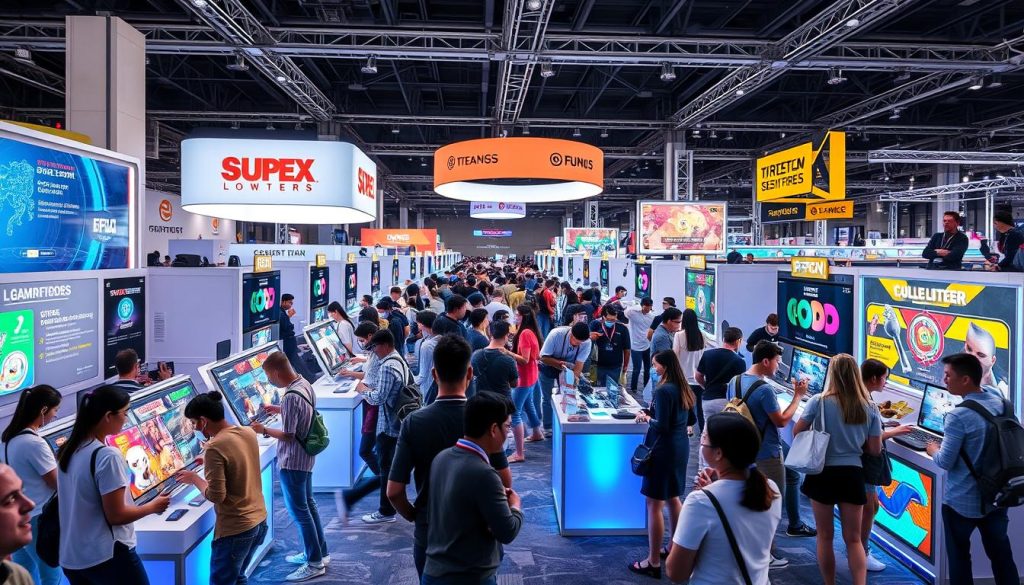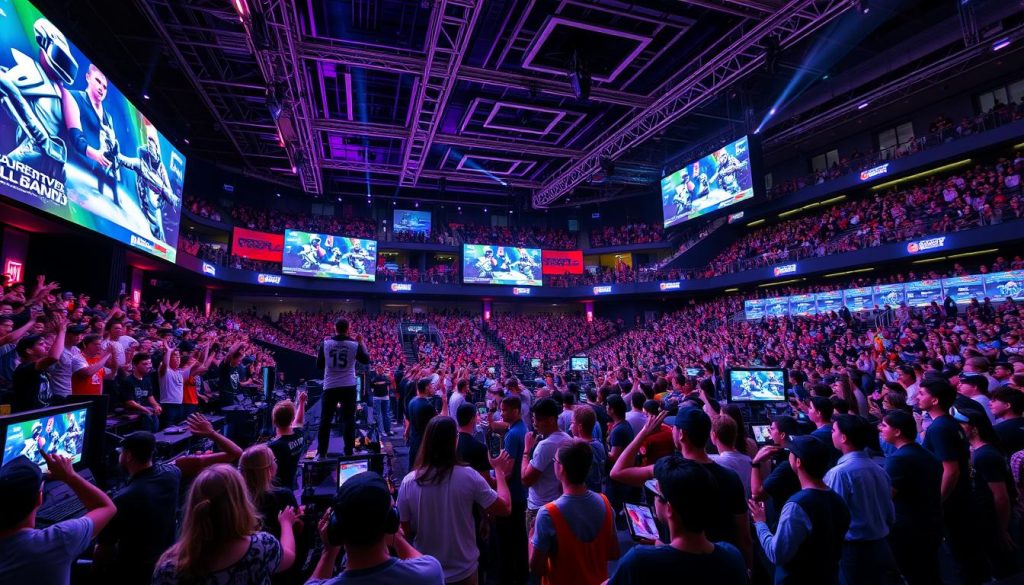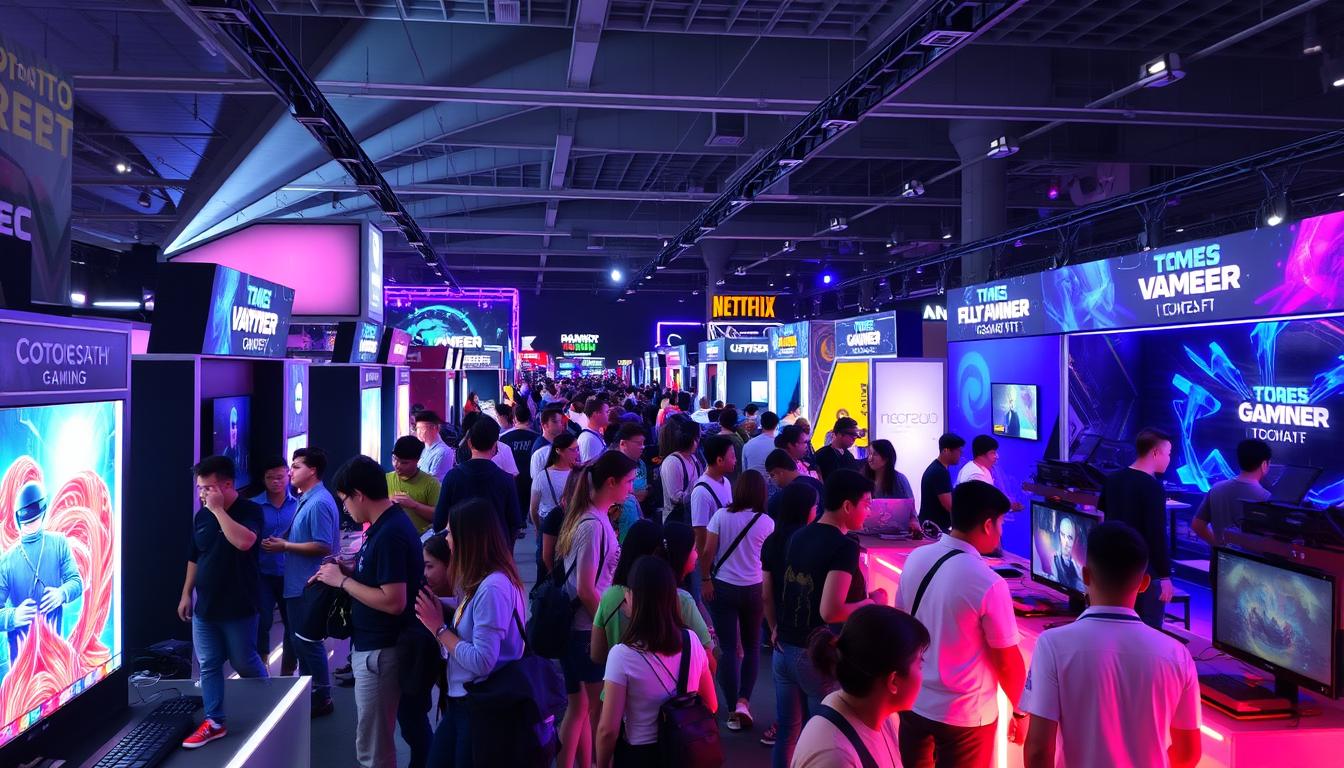Gaming expos are changing the way we think about trade shows. Gone are the days of static displays and passive browsing. Today’s expos are all about immersive technology and interactive experiences that pull you right into the action.
From virtual reality demos to hands-on gaming stations, these events are transforming into digital playgrounds. Attendees can now test upcoming games, chat with developers, and even compete in live tournaments.
This shift marks a turning point for the expo industry. It’s not just about showing off products anymore. It’s about creating memorable, engaging experiences that stick with visitors long after they leave.
Key Takeaways
- Gaming expos are leading the charge in trade show innovation
- Interactive experiences are becoming the norm at modern expos
- Immersive technology is reshaping how products are showcased
- Attendees now expect hands-on engagement with exhibits
- The future of expos lies in creating lasting, memorable experiences
Evolution of Traditional Expos to Digital Platforms
Trade shows have been a cornerstone of business networking for decades. From bustling convention centers to packed exhibition halls, these events have long been the go-to for industry professionals seeking new connections and opportunities. But times are changing, and so are expos.
Historical Perspective of Trade Shows
Traditional expos were all about face-to-face interactions. Picture rows of booths, handshakes, and business card exchanges. These events were vital for product launches, deal-making, and industry updates. But they had limitations – travel costs, time constraints, and limited reach.
Digital Transformation Impact
Enter the digital age. Virtual reality and online platforms have revolutionized how we connect. Digital expos break geographical barriers, allowing global participation. They offer 24/7 access, data-driven insights, and cost-effective solutions for both organizers and attendees.
Hybrid Event Models
The future of expos lies in hybrid models. These blend the best of both worlds – the energy of in-person events with the reach of digital platforms. Augmented reality enhances physical booths, while virtual reality creates immersive online experiences. This dual approach caters to diverse preferences and maximizes engagement.
| Feature | Traditional Expos | Digital Platforms | Hybrid Models |
|---|---|---|---|
| Reach | Local/Regional | Global | Global + Local |
| Interaction | Face-to-face | Virtual | Both |
| Cost | High | Low | Moderate |
| Duration | Fixed dates | 24/7 access | Extended access |
As we move forward, the evolution of expos continues. The integration of cutting-edge technologies promises even more innovative and engaging event experiences for all involved.
Virtual Reality Revolutionizing Expo Experiences
Virtual reality is transforming the expo landscape, offering immersive technology that captivates attendees like never before. This cutting-edge tech is reshaping how businesses showcase products and interact with potential clients.
VR Exhibition Halls
VR exhibition halls transport visitors to stunning digital environments. These spaces blend the best of physical and virtual worlds, creating interactive experiences that leave lasting impressions. Attendees can explore intricate product details and engage with exhibits in ways impossible in traditional settings.
Interactive Product Demonstrations
Virtual reality enables lifelike product demonstrations that go beyond static displays. Visitors can manipulate 3D models, test features, and even customize products in real-time. This hands-on approach enhances engagement and boosts conversion rates, making it a powerful tool for businesses.
Virtual Networking Spaces
VR technology is revolutionizing networking at expos. Virtual meeting rooms and social spaces allow attendees to connect from anywhere in the world. These digital environments facilitate spontaneous interactions, scheduled meetings, and group discussions, breaking down geographical barriers.
| Feature | Traditional Expos | VR Expos |
|---|---|---|
| Accessibility | Limited by location | Global reach |
| Product Interaction | Physical samples | 3D virtual models |
| Networking | In-person only | Virtual and in-person |
| Cost | High (travel, booth setup) | Lower (digital assets) |
As immersive technology continues to evolve, the potential for creating unforgettable expo experiences grows. VR is not just a novelty; it’s becoming an essential tool for businesses looking to stand out in a crowded marketplace.
Augmented Reality Integration in Modern Expos
Augmented reality (AR) is transforming the expo landscape. This tech marvel blends digital content with the real world, creating immersive experiences that captivate attendees. AR enhances fan engagement by allowing visitors to interact with products in ways never before possible.
Picture walking through an expo hall and pointing your smartphone at a display. Suddenly, a 3D model pops up, showcasing every angle of the product. This level of interactivity is driving gamification in expos, turning browsing into an adventure.
Exhibitors are using AR to create memorable brand experiences. Visitors can try on virtual clothing, test drive cars without leaving the booth, or even visualize furniture in their homes. These engaging demos boost interest and sales potential.
“AR has revolutionized how we showcase products at expos. It’s not just about seeing anymore; it’s about experiencing,” says a leading tech exhibitor.
The benefits of AR in expos extend beyond individual booths. Organizers use it to guide attendees through venues, provide real-time translations, and offer personalized recommendations. This integration of technology enhances the overall expo experience, making navigation seamless and discovery exciting.
| AR Feature | Benefit for Exhibitors | Benefit for Attendees |
|---|---|---|
| 3D Product Visualizations | Showcase full product range in limited space | Explore products in detail |
| Interactive Demos | Increase engagement and memorability | Try before buying |
| Wayfinding | Direct traffic to booth | Easy navigation through expo |
| Personalized Experiences | Tailor pitches to individual interests | Receive relevant information and offers |
As AR technology evolves, its role in expos will only grow. The future promises even more immersive experiences, blurring the lines between physical and digital worlds, and revolutionizing how we interact at these events.
Gamification Elements Reshaping Attendee Engagement
Expos are evolving, taking cues from esports and live streaming to create more engaging experiences. Gamification is at the forefront of this change, transforming how attendees interact with exhibitors and content.

Points and Rewards Systems
Expo organizers are implementing point-based systems to encourage participation. Attendees earn points for visiting booths, attending presentations, or engaging with exhibitors. These points can be redeemed for prizes, exclusive content, or VIP experiences, mimicking the reward structures found in popular esports tournaments.
Interactive Challenges
Drawing inspiration from live streaming platforms, expos now feature interactive challenges throughout the event. These might include scavenger hunts, trivia contests, or skill-based competitions. Attendees can track their progress and compete with others, fostering a sense of community and friendly competition.
Achievement-Based Exploration
Expos are adopting achievement systems similar to those in video games. Attendees unlock badges or titles for completing specific actions or exploring certain areas of the expo. This gamified approach encourages thorough exploration of the event and increases engagement with exhibitors.
| Gamification Element | Benefits | Examples |
|---|---|---|
| Points System | Increased participation | Booth visit points, presentation attendance rewards |
| Interactive Challenges | Enhanced engagement | Scavenger hunts, trivia contests |
| Achievement System | Thorough event exploration | Unlockable badges, progress tracking |
By incorporating these gamification elements, expos are creating more dynamic and engaging environments. Attendees are no longer passive observers but active participants in a gamified experience that blends the excitement of esports with the informative nature of traditional expos.
Rise of Esports Events within Traditional Expos
Esports events are taking the expo world by storm. These competitive gaming showcases are transforming traditional trade shows into thrilling spectacles. Expos now buzz with the energy of virtual battles and digital champions.
Fan engagement has skyrocketed thanks to esports integration. Attendees flock to watch pro gamers compete live, creating an electric atmosphere. This shift has opened new doors for experiential marketing strategies, allowing brands to connect with younger audiences in innovative ways.
Sponsorship opportunities have exploded with this trend. Companies now vie for prime spots on gaming stages and player jerseys. The fusion of esports and expos has birthed a new ecosystem of partnerships and promotions.
“Esports at expos isn’t just a trend; it’s a revolution in how we experience trade shows,” says Sarah Chen, expo marketing expert.
The impact on expo design is significant. Organizers now craft spaces tailored for gaming competitions and spectator viewing. High-tech arenas with massive screens and state-of-the-art sound systems have become standard features.
- Interactive gaming zones for attendees
- Meet-and-greet sessions with esports stars
- Product launches tied to gaming events
As esports continues to grow, its presence at expos is set to expand further. This blend of digital competition and physical gatherings is reshaping the expo landscape, promising an exciting future for event organizers and attendees alike.
Live Streaming and Digital Broadcasting Evolution
The expo landscape is changing fast. Live streaming and digital broadcasting are taking center stage. These tools are expanding the reach of expos beyond physical venues. They’re creating new ways for people to engage with events from anywhere in the world.
Multi-Platform Broadcasting
Expos are no longer confined to one platform. They’re now streamed across multiple channels. This includes social media, dedicated apps, and websites. It allows viewers to tune in from their preferred devices. Whether it’s a smartphone, tablet, or smart TV, the expo is just a click away.
Interactive Viewer Participation
Gone are the days of passive viewing. Today’s expos encourage active participation. Viewers can ask questions in real-time, vote on polls, and even interact with virtual reality displays. This level of engagement makes viewers feel like they’re right there at the event.
Real-Time Analytics
Digital broadcasting brings a wealth of data. Organizers can track viewer numbers, engagement rates, and popular content in real-time. This information helps them adjust the expo on the fly. They can focus on what’s working and improve areas that aren’t.
The future of expos is bright with these digital advancements. Augmented reality is set to play a big role too. It will blend the physical and digital worlds, creating immersive experiences for all attendees, whether they’re there in person or tuning in from afar.
Immersive Technology Advancing Exhibition Design
Exhibition design is undergoing a revolution. Immersive technologies are transforming the way we experience expos. Gone are the days of static displays and dull presentations. Today’s expos wow visitors with interactive experiences that engage all the senses.
Virtual reality (VR) is leading this charge. Exhibitors use VR to transport attendees to virtual worlds. Imagine exploring a new car’s features while “driving” it through a cityscape. Or picture walking through a home you’re considering buying, all without leaving the expo floor.
Augmented reality (AR) adds digital elements to the real world. Visitors can use their smartphones to see product specs or watch demos overlaid on physical objects. This blend of digital and physical creates a rich, layered experience that’s hard to forget.
“Immersive tech is not just a gimmick. It’s a powerful tool for engagement and education,” says a leading expo designer.
Gamification is another trend reshaping expos. Companies create challenges and quests for attendees to complete. These games make learning about products fun and memorable. Visitors earn points, compete with others, and win prizes. This gamified approach keeps people engaged long after they leave the expo.
The future of expos is bright and immersive. As technology advances, we can expect even more innovative ways to create unforgettable exhibition experiences.
Fan Engagement Through Interactive Experiences
The future of expos lies in creating unforgettable interactive experiences. Organizers now focus on engaging fans through personalized journeys, social media, and community-building features. This shift mirrors trends in esports and live streaming, where audience participation is key.
Personalized User Journeys
Expos now offer tailored experiences for each attendee. By using data analytics, organizers craft unique paths through the event. This approach, similar to personalized shopping experiences in ecommerce, keeps visitors engaged and interested throughout their visit.
Social Media Integration
Social platforms are no longer just for promotion. They’re now integral to the expo experience. Attendees share real-time updates, join live polls, and interact with exhibitors. This integration creates a buzz that extends far beyond the event space.
Community Building Features
Expos are fostering lasting connections among attendees. Forums, chat rooms, and networking tools help build communities around shared interests. These features keep the conversation going long after the event ends.

| Engagement Feature | Benefits | Example Application |
|---|---|---|
| Personalized Journeys | Increased satisfaction, longer visit times | AI-powered event app suggesting booths |
| Social Media Integration | Wider reach, real-time feedback | Live Twitter wall at esports tournaments |
| Community Building | Long-term engagement, brand loyalty | Post-event forums for streaming enthusiasts |
By embracing these interactive elements, expos are transforming into dynamic, engaging experiences that resonate with modern audiences. The fusion of technology and human connection is setting a new standard for fan engagement in the digital age.
Future Technologies Shaping Next-Gen Expos
The world of expos is evolving rapidly, with cutting-edge technologies paving the way for immersive and personalized experiences. As we look to the future, three key innovations stand out in their potential to revolutionize the expo landscape: AI-powered personalization, blockchain integration, and 5G implementation.
AI-Powered Personalization
Artificial intelligence is set to transform experiential marketing at expos. By analyzing attendee data and behavior, AI can create tailored experiences for each visitor. This level of personalization enhances engagement and streamlines event management processes, making expos more efficient and enjoyable for all involved.
Blockchain Integration
Blockchain technology is poised to enhance security and transparency at expos. From secure ticketing systems to verifiable digital credentials, blockchain can build trust and streamline operations. This innovation could revolutionize how we handle transactions and data at large-scale events.
5G Implementation
The rollout of 5G networks will supercharge immersive technology at expos. With lightning-fast speeds and low latency, 5G will enable seamless virtual reality experiences, real-time interactive displays, and high-quality live streaming. This advancement will blur the lines between physical and digital expo experiences, opening up new possibilities for exhibitors and attendees alike.






